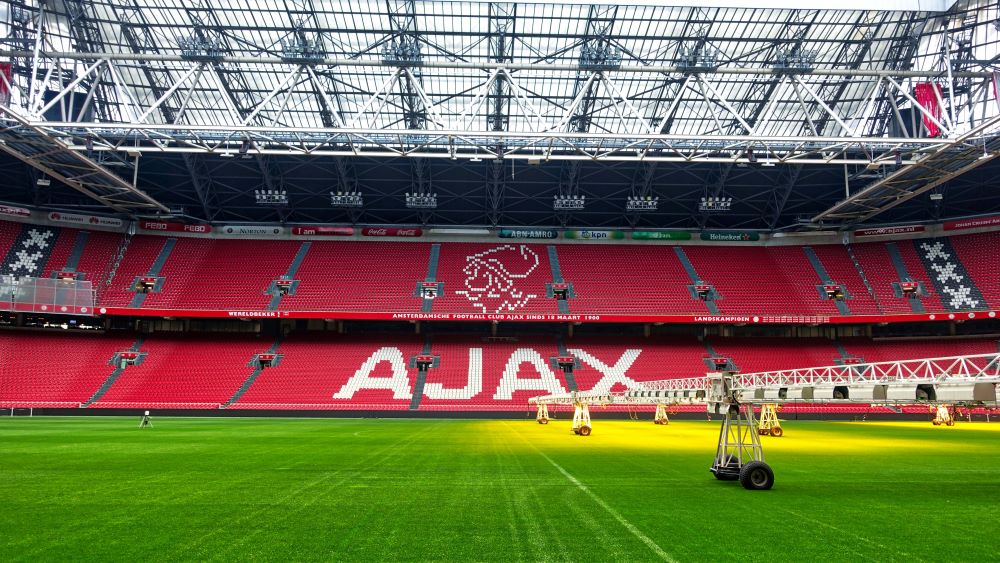Johan Cruijff Arena is about more than soccer – much more. It’s a high-tech testbed for all manner of cutting-edge innovations. Because of this, it’s one of the most sustainable spots in Europe. Picture solar panels, super-green energy storage and perhaps our favorite eco-friendly initiative: onsite vehicle-to-grid charging.
A bold mission
The stadium opened in 1996 to serve as the new home of the top-tier Dutch soccer team AFC Ajax, which had outgrown its former facility. Being Amsterdam’s main stadium, many concerts also take place at the venue; The Rolling Stones, Genesis, Madonna and Beyoncé have all graced the stage.
The arena was always a beacon for innovation thanks to its dynamic, multifunctional design which includes a retractable roof. As the metropolis that surrounds it began to embrace the Smart City concept by implementing sensors and smart energy management, so did the stadium. Today, the facility operates with an energy carbon footprint of zero, accomplishing a bold and important mission. Here’s what makes it possible.
A dream realized
The arena is a prime example of sustainability at scale. Consider the huge solar-plus-storage system: over 4,200 rooftop solar panels forming part of a one-megawatt (MW) system supply the stadium with clean energy, and excess power is stored in a three-MW energy storage system comprised of new and recycled batteries. Specifically, the equivalent of 148 used Nissan Leaf batteries have found a second life in this system, which has the distinction of being the largest energy storage bank in a commercial building in Europe.
With a capacity of 2.8 MWh, the arena’s battery can balance the differences in energy supply and demand, provide clean backup power during a blackout and even help balance the country’s electricity grid by providing frequency regulation services upon the request of grid operators.
Naturally, the smart energy considerations don’t stop there. Johan Cruijff Arena envisions a future in which its 2,000 parking spaces are filled with electric vehicles (EVs) plugged into smart chargers. When the stadium experiences peaks in its electricity load, each EV would quickly pitch in to provide clean local energy and avoid costly strains on the grid. The onsite smart chargers would ensure that this peak shaving doesn’t prevent all the EVs from being fully charged by the time the match ends or the performer hits their final note.
The stadium took a concrete step towards that vision in 2019 when it installed the first of 15 vehicle-to-grid (V2G) charging stations. The bidirectional infrastructure is set up so that EV owners must provide consent before V2G charging takes place. For context, as of 2021, only EVs built to the CHAdeMO charging standard like the Nissan Leaf can provide V2G services. However, vehicles that feature CCS outlets may also be able to perform V2G charging as early as 2022, setting the stage for V2G to become commonplace. That’s why the stadium’s embrace of V2G provides a fascinating sneak peek at the future of electric mobility and distributed energy.
Data-driven advantages
Several terabytes of onsite data are collected at Johan Cruijff Arena on a daily basis. A cloud-based platform helps make sense of it all, allowing the facility to make data-driven decisions that positively impact business, visitor safety and facility management.
Even the grass is constantly monitored, allowing groundskeepers to manage the soil’s nutrient content. Sensors let them know how much water, ventilation and lighting is needed to keep the pitch in top shape. The bounce and roll of a soccer ball can be measured, and even the lawnmowers contain advanced sensors that enable a customized maintenance routine.
Big data has allowed the fan experience to improve at the 55,000-seat stadium. Visitors can get real-time directions to their seats, and smart crowd management improves security. The main objectives of the entire project were to increase revenues by 20 percent and decrease costs by the same amount. Sander van Stiphout, the arena’s innovation director, said that those goals are close to being met.
Standing ovation
Johan Cruijff Arena is a shining example of sustainable thinking. The company’s motivation to be a productive and responsible actor in the community is evident, and the success it has seen is mostly thanks to an approach that welcomes large companies and startups alike to experiment with their respective solutions in an open-minded space.
The speed of the stadium’s innovation timeline is inspiring. In just a few years, the venue managed to integrate disparate sustainability technologies and cutting-edge sensors which all work together for the benefit of the venue’s patrons and the city of Amsterdam. All the experiments trialed in the arena’s innovation lab are designed to be exported to other stadiums and buildings – here’s hoping that this spirit of collaboration leads to similar success stories around the world.
Sources:
https://home.kpmg/xx/en/home/insights/2020/07/client-story-johan-cruijff-arena.html
Smart City: How Amsterdam Revolutionizes Energy | Future Smart City Projects (YouTube)
High tech pitch Johan Cruijff ArenA (YouTube)
https://www.johancruijffarena.nl/en/over-ons/duurzaamheid/
https://johancruyffinstitute.com/en/blog-en/sport-management/johan-cruijff-arena-a-smart-stadium/
https://www.eaton.com/ca/en-gb/products/energy-storage/johan-cruijff-arena-success-story.html
Photos by Junpeng Ouyang on Unsplash


